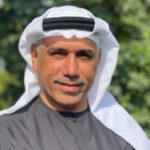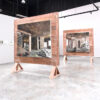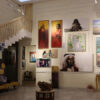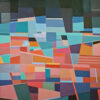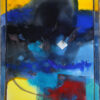• New concepts in sculpture and a deliberate demolish of imitating preferences
• His works are inspired by nature and biased toward it
• Breaking the ideal harmony between the mass and the space
• The sculpturing form is shaped while creating the art piece
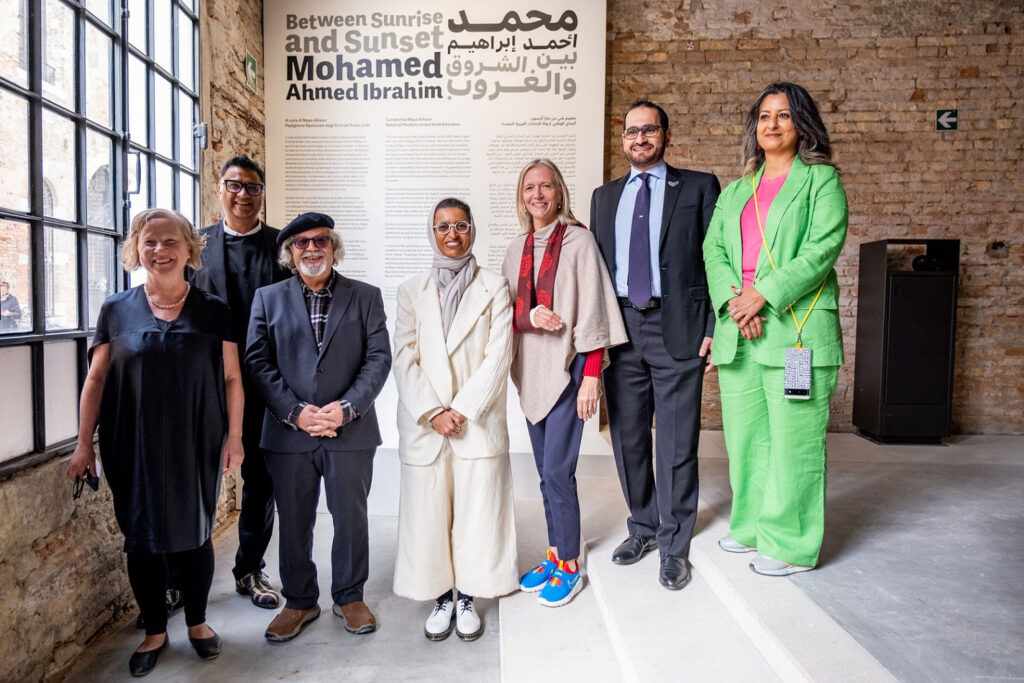
With the presence of her Excellency Noura bint Mohammed Al Kaabi, the Minister of Culture and Youth, UAE has participated in the 59th edition of La Biennale Di Venezia 2022, thus adding a qualitative accumulation to its previous seven participations in this international exhibition. The exhibition has focused this year on three topics which are the “representation of bodies and their metamorphoses”; “the relationship between individuals and technologies”; “the connection between bodies and the Earth”. The artworks of Mohammad Ahmad Ibrahim, the Emirati artist, were
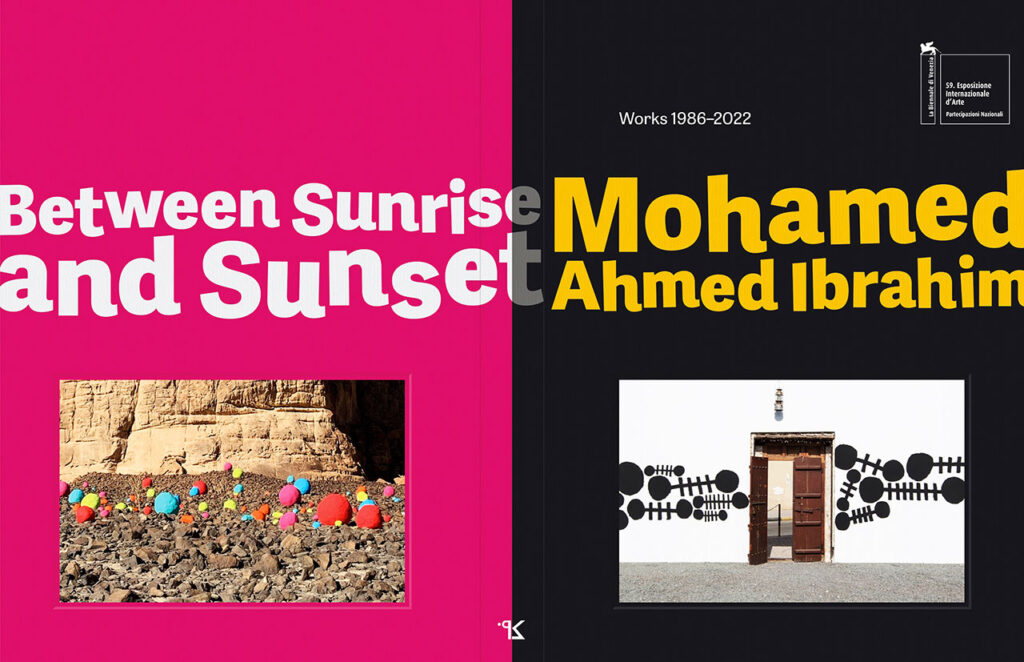
chosen to be displayed in this edition for their resonance with the general theme of the exhibition, since he merges painting and sculpture, and many of his pieces focus on creating communication among bodies, nature, and earth.
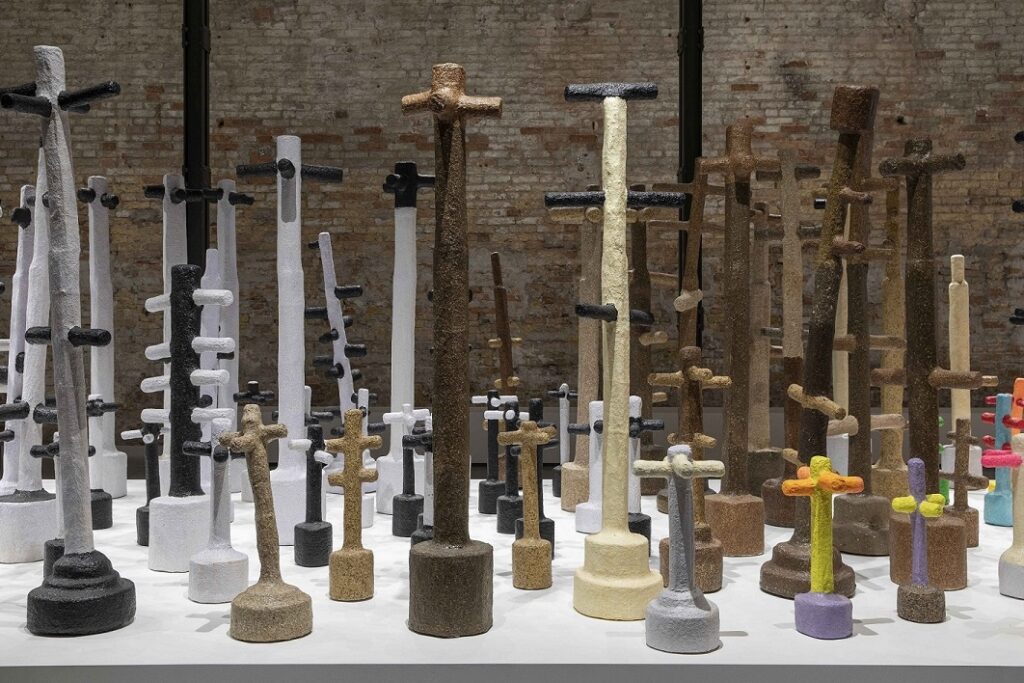
The exhibition holds a title related to time (Mohamed Ahmed Ibrahim: Between Sunrise and Sunset) and is curated by Maya Allison, Executive Director of The New York University Abu Dhabi Art Gallery and Chief Curator at New York University Abu Dhabi. The artworks displayed were the culmination of this artist’s experiences in his career that extended for 40 years, during which he shifted schools and movements, until he found one of his own.
The National Pavilion of UAE revealed, on the margins of this participation, some details about the publication “Mohamed Ahmed Ibrahim: Between Sunrise and Sunset / Works 1986 – 2022”. The National Pavilion in la Biennale di Venezia is commissioned by the Salama bint Hamdan Al Nahyan Foundation and supported by the UAE Ministry of Culture, Youth and Community Development. The book introduces a comprehensive exploration of this artist’s work, including the abstract paintings he created, his experiences in working with natural materials and creating Land Art in the 80s and the 90s, and the way his experiences later developed in producing sculptures and structures. The book was under the supervision of Cristiana de March, the Italian artist residing in UAE, and was co-authored by a number of critics and writers.
Over the years, Salama bint Hamdan Foundation, a non-profit organization, has contributed to the growth and development of the community of UAE, by supporting innovation and the interconnection among all sectors. The foundation supervises, from its headquarters in Abu Dhabi, a wide range of programs and initiatives in various areas; art, culture, heritage, human development, and Early Childhood development within the UAE and outside. The Foundation’s activities aim to invest in knowledge and enhance the capabilities of Emirati individuals, by helping them explore their skills, capabilities, and talents so they can reach their full potential. The foundation is also one of the key sponsors of the Emirati artist’s participation in the Venice Biennale.
We will try here to explore this artist’s journey from the first beginnings until he arrived at La Biennale di Venezia, and the milestones that impacted his experience…
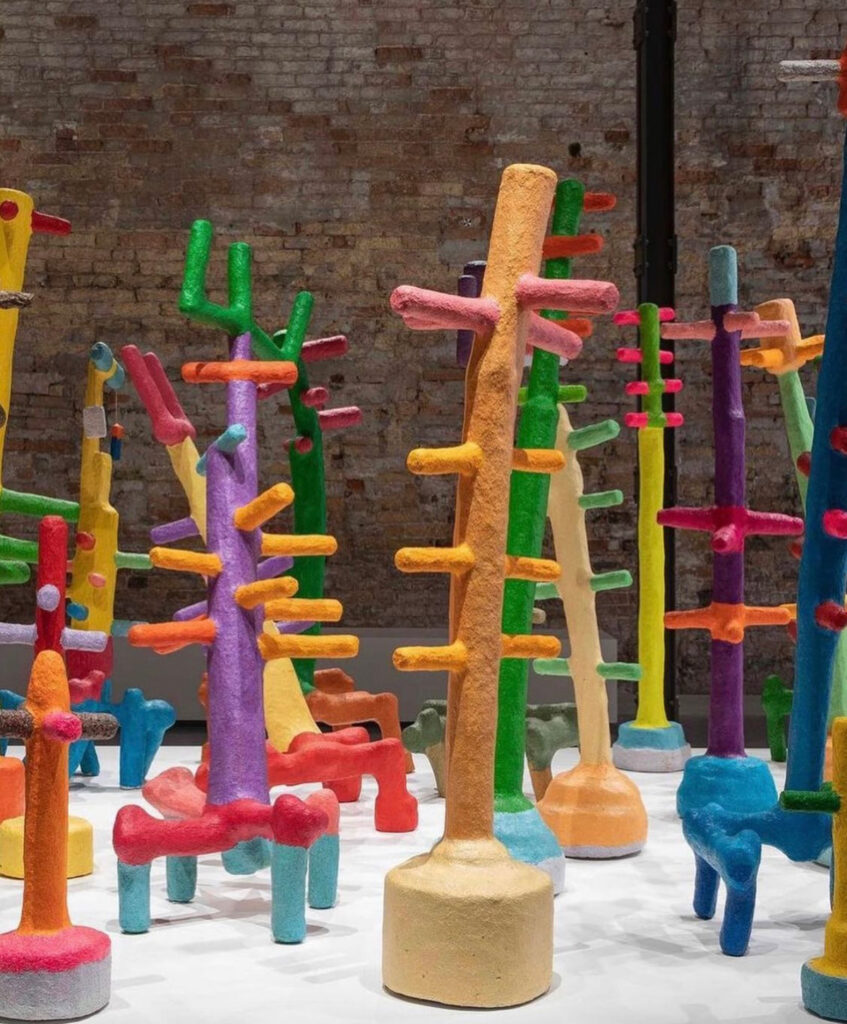
A Leap to Start
In a mountainous city, with a view of the sea named “Khor Fakkan” in the United Arab Emirates. The habitants of this city can enjoy the sunrise scene in the morning from the seaside, but the scene of sunset is blocked by the high mountains surrounding the city in the west. In these charming spaces, Mohamed Ahmed Ibrahim grew up. He had his first childhood goofs, and studied in its schools. Once he reached high school, he felt the artistic spirit calling him from within, as he was assigned to draw maps and educational materials. His teachers encouraged him to pursue his drawing talents, but due to the lack of capabilities back at the end of the 70s, he was not able to acquire the artistic tools he needed, the canvases, or the appropriate studio to unleash his talents, thus he needed to search for another place in which he can nourish this artistic spirit.
Since Khor Fakkan had some active cultural spots in theater and in poetry, he tried to write and created many reflection pieces, and even some prolonged theatric plays. However, this did not last for long. As soon as he graduated from high school in 1980, he was granted a scholarship to study the ruins of Lahore, the Pakistani capital city. A year later, he came back. He found that the ruins, in spite of their historic significance, were not the world he was seeking.
At United Arab Emirates University
After the last experience, he only had to enroll in UAE University in 1982. The university didn’t have a faculty for fine arts, so he chose to study psychology while pursuing his artistic interests, which he made up for by reading in the university library, in which he found all the books and sources on art theories and new philosophies. In the university, he got to know many young poets and artists from the new generation, aspiring for renewal, change, and modernism. At that stage, he started to leave his prints with the arts he drew on the covers of the poetry books written by his friends, or in the posters and literature magazines
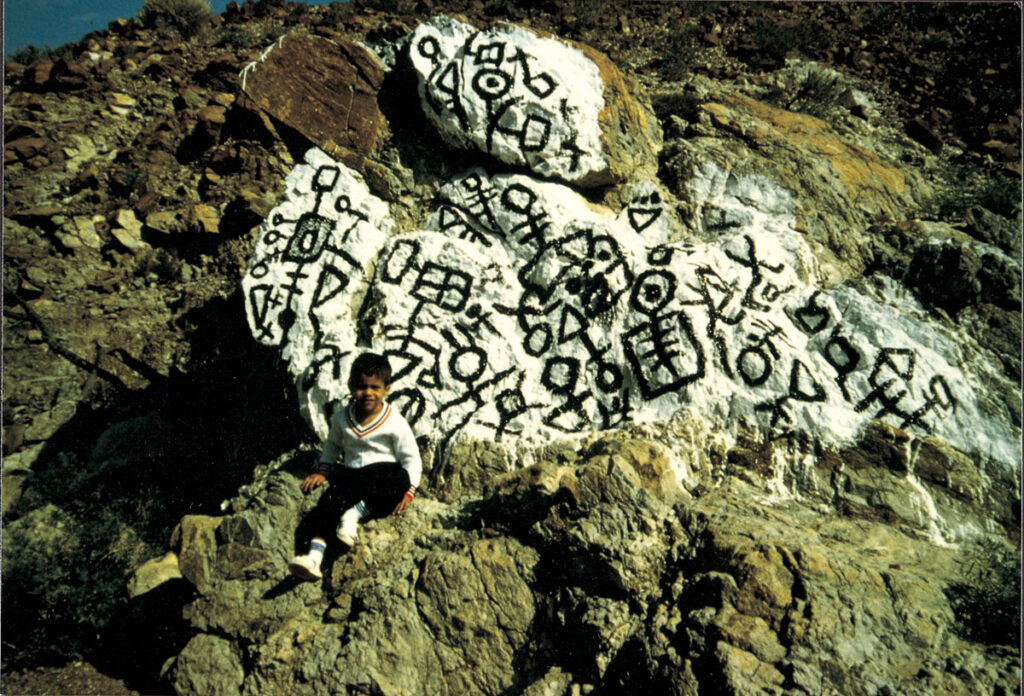
issued by the sole efforts of the youth. Some of his friends in that period were poets Aḥmad Rashid Thani and Ali Al Andal, artists Marie Al Halian and Abdullah Alowais, and many others.
The first half of the 80s has witnessed a major cultural transformation in UAE, and it greatly affected the minds of a whole generation in the country. During those years, Sharjah International Book Fair was launched, and it created a huge intellectual leap. Then it was followed by Abu Dhabi Book Fair, and the Emirates Fine Arts Society was founded in 1980 in Sharjah. Right after, the Society started to organize an annual exhibition for their followers, and the daily newspapers started to assign pages and cultural addendums concerned with literature and visual arts. The art galleries were increasing in number, and the seminars and literature nights were held so frequently. In addition to that, many of the Emirati artists, from those sent to study art in Egypt, Iraq, and England happened to come back, and some of the artistic Arab key figures chose to live and work in the Emirati Journalistic and Intellectual sectors. This was a major and truly illuminating moment, and Mohamed Ahmed Ibrahim’s grandfather himself was living in it. He kept visiting exhibitions, keeping up with the modern and contemporary debates in the newspapers, and attending the seminars and disputes between those who are with modernism and those who are against it. His artworks have found their way to the annual exhibitions, organized by the fine art society. Before the 80s were over, Mohamed Ahmed Ibrahim name was already a promising and uprising name in the world of art and intellect.
Between Painting and Sculpture
Many of Mohammad Ahmad’s first pieces were about experimenting in two areas; painting and sculpture. In painting, he started to configure shapes resembling hieroglyphic letters and old inscriptions, while focusing on creating patterns by repeating those shapes. These inscriptions have moved from paper and sketches on the walls, then to the mountain trails and trees, these procedures were like an open workshop in nature.
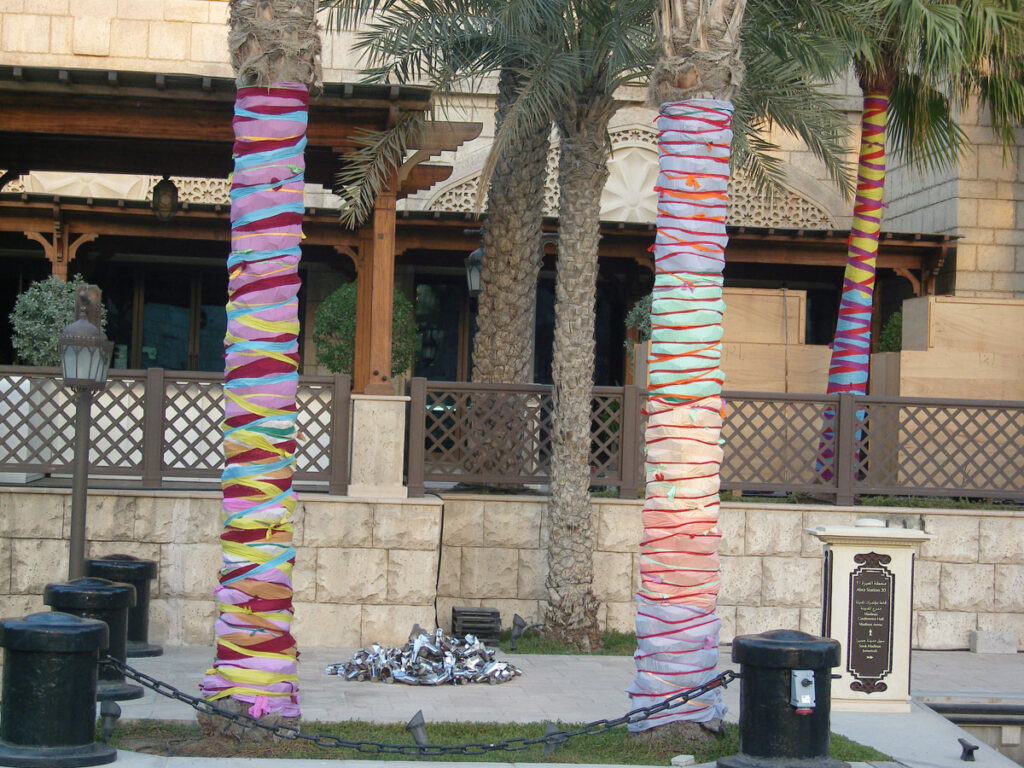
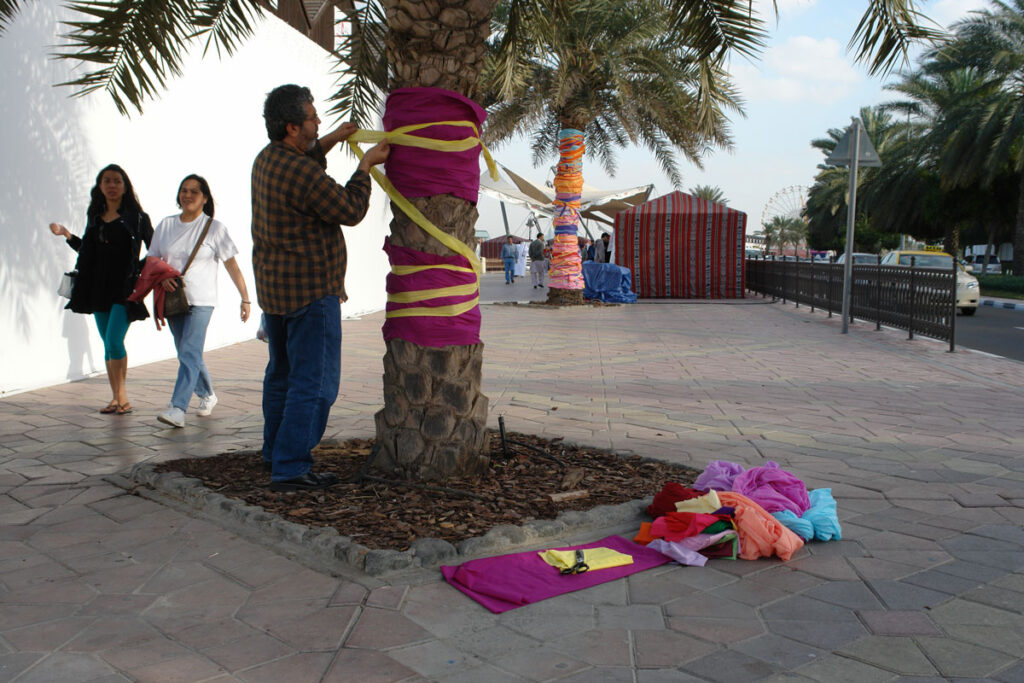
Mohammad Ahmad Ibrahim has portrayed his experiences in a new conscious and in a new style, but he was always finding himself confronting the traditional conscious. At that time, the advocates for renewal have been going through violent conflicts with the traditional and conservative parties, and the artists who tried to break the intellectual stereotypes and called for adventuring in art have been the recipients of a violent attack from traditions advocated, especially after they saw that the abstract painting and the conceptual, experimental, and performance arts have shaken their artistic beliefs. However, nothing could stand in the way of developing ideas and communities. The other movements, trends, and schools have rushed to intervene, and sooner than later, change has extended to reach everything. Mohammad Ahmad Ibrahim have chosen to fight on the side of the renewing, and he saw himself as one of the champions of this battle as he started to create artworks that break the concept of a painting, and the mountain trails of Khor Fakkan found their spot in his open art gallery, and the solid stones have become his gentle tools.
Of the artworks of that period, we mention:
- Wrapping leaves and colorful pieces on the trees.
- Paintings displayed in the annual galleries of the Fine Artist Society
- Paintings on the book covers and magazines of many poets.
- Paintings on the walls, rocks, and mountains in Khor Fakkan.
The Great Friendships: Hassan Sharif and Jos Clevers
Back at the end of 1986, Mohammad Ahmad met Artist Hassan Sharif (1951 – 2016), who graduated from Byam Shaw School of Art in London. Hassan Sharif has managed to prep and lay the foundations for conceptual art in UAE, while advocating to break the traditional concept of a painting, following and sharing the ideas of Marcel Duchamp, in particular, his refusal to create a piece of art just for the pleasure of looking at it. Instead, Duchamp has always wanted to use art to serve the mind.
At that point, Mohammad Ahmad Ibrahim had entered the orbit around Hassan Sharif, becoming one of his best friends. He became in touch with all the artists of that time, and got to know their experiences and check their exhibitions. He used to visit the major cultural cities of Abu Dhabi, Dubai, and Sharjah, but he always came back to the mountains and the trees in his faraway city, to get to freely practice his own brand of insanity. He kept on wrapping trees in brightly colored fabrics in the public streets, as he was deliberately trying to shock the public taste and way of thinking. Inscribing the rocks in nature was not enough, so he carried them with him to the city, and displayed them in the gallery. After that, the idea evolved, so he started to paint on the rocks of the mountains and carve amulets and symbols, similar to the old cave paintings. This was met with acceptance from some people while provoked the others. Later on, people saw him tying stones with plastic and metal wires, and while he was having more fun, many were puzzled by this weird artistic behavior, although these practices were wildly known internationally as “Land Art”, and its schools were present around the world.
Between UAE and Netherlands
In yet another great friendship, Mohammad Ahmad Ibrahim was also associated with the Dutch artist Jos Clevers. He used to frequent his studio in Sittard, Netherlands, and he arranged gatherings for this artist, and introduced him to his Emirati artists friends, who were conceptual artists (Hassan Sharif, Mohammed Kazim, Abdullah Al Saadi, and Hussein Sharif) along with Mohammad Ahmad. These gatherings and friendships had deeply influenced Mohammad Ahmad’s experience, and he saw in them the philosophical and referential sources, and the artistic space in which he can freely express himself. This has led him to dig deeper and further suggest new ideas with new concepts in his artwork, thus leading him to this open and transitional stage between painting and sculpture.


During the 90s, Mohammad Ahmad’s name was recurring in art galleries, in the UAE and outside it. He also held his solo exhibition in Sharjah, in which he displayed his collection of rocks, wrapped with wires and plastics, and the paintings and photographs of his art practices in the streets. He added another depth to the exhibition by creating sculptures out of clay and raw papier-mâché, and introducing new shapes, in which he utilized the harmony of mass and space, for which he was awarded Sharjah Biennial prizes (two times) in sculpture, and his artworks were showcased in many international events in Europe and Asia. Those artworks were unique for their genuine and real connection with the spirit of place and earth, as the clay he used for his sculptures was made out of tree barks, wooden pieces, sand, and cardboard, that he mixed and dried himself. As for the shape, each sculpture had its own configuration, which was manifested and shaped during the artwork design stage, so that no shape was repeated twice. Each piece managed to occupy a space and stand on its own.
This artist, over a period of 30 years, kept engaging in new artistic experiments, inventing his own language, and gaining new knowledge every day. He traveled to Art Residency programs in many European and Asian countries, and participated in some of the world’s biggest art exhibitions. His artworks were displayed in many museums until he managed to arrive at La Biennale di Venezia, the world’s biggest art forum, under the patronage and unlimited support of the UAE and its art foundations.
La Biennale di Venezia… Concepts, ideas, and visions
(Mohamed Ahmed Ibrahim: Between Sunrise and Sunset) exhibition has introduced many of the concepts in which this artist has believed. Those concepts try to frame his perception of art, and determine his visual language and his vision of the world and the whole existence. Here we mention some of the core ideas that we can derive from these artworks:
Sculpture concept
The sculpture has remained, throughout its history, serving the traditional patterns of embodying the 3D models of human and animal shapes. Later, it evolved to incarnate the abstract pieces, while keeping the (perfection) element in coordinating the angles of the materials, the flow of the configurations, and the geometric dimensions of the piece. We can notice the absence of that idealism in Mohammad Ahmad’s pieces that he presented in La Biennale, as we can see the random shapes with uneven edges and lines, and they clearly don’t commit to any sense of order. They’re self-generated, like a rudimentary element that is arbitrary rather than neatly geometric. Declaring the choice of belonging to nature, and the attempt to search for beauty in itself, not in its perfection.
Bright Screaming colors
The question of why Mohammad Ahmad chooses these bright screaming colors for his sculptures in a way that they almost resemble children’s toys couldn’t have a simpler answer; he wants to shatter the traditional view of the sculptural matter that it serves a beneficial or aesthetical purpose. By that, he’s adding the bright color element so he could cancel out the original color, and this is a demolishing and an abstracting act at the same time. So the sculptures seem to be wearing this color to cover their essence, and the viewer has to look deep behind those colors to unravel their depths. Exactly as it is with humans, since their appearance and bright colors could easily deceive the beholder.
The Meaning of the Shape
A question that could occur to anyone passing by these sculptures is “Does the mere shape in itself carry any meaning?”. To put it in other words, what is the artist’s intention when he creates these weird shapes, which we cannot tell whether they were for animals or people? Why didn’t he follow the classical dimensions and rules of the sculptural work so we can be exempted from the task of contemplating and searching for the truth? To this, he might simply respond: because the sculptural piece is fortuitous and a product of the moment; it doesn’t incarnate the features of something in itself. Those are free sculptural configurations that can take their own shape when the artist is creating his artwork. They derive their shape from his hand movements and from his mental explorations while innovating the sculptural configuration. The viewer could associate these configurations with an incarnation or an imagined shape in his mind, but then when he looks closely, and circles around the piece, he will find nothing but the idea that this piece represents itself, and itself only. It doesn’t resemble humans, animals, or plants but rarely.
Land Art
While many artists resort to burning, hard metals, and chemicals, Mohammad Ahmad chooses to belong to the earth. He considers his studio in Khor Fakkan to be a factory in which he produces the materials he uses; the remnants of cardboards, organic materials, starch, tree bark, glue, and some tealeaves and tree leaves. This process is not only harmless to the environment but also recycles waste and reuses them in creating artworks. For that, these artworks can be left in nature and in mountains, and can see the sun (from sunrise till sunset) without being a threat to any creature.
The Abstract Color Dimension
We have noticed that some of the sculptures in Mohammad Ahmad’s exhibition in Venice were colorful, while some others were left in brown, which is the color of the clay itself, and in white, in the middle stage in between the original color and the painting stage. It was as if he meant to emphasize the idea that any artwork takes on a changing concept at every stage of creation. Many elements were playing a role in that vision. One of them is the element of (change) which is considered a fixed dimension, just like a human being who (never steps in the same river twice), so however he moves, he sees the piece differently as the angle changes, and the color changes along with it, in an infinite non-stopping process.
The artistic process constantly needs this break of patterns and awakening of imagination so it can always come up with new creations. For that, the real artist is the one who owns this creative imagination, and the courage to decline the ready-made traditional patterns, so they can come up with new alternating concepts that can pave the way for new knowledge and can stir up the desire to go beyond all the limits.
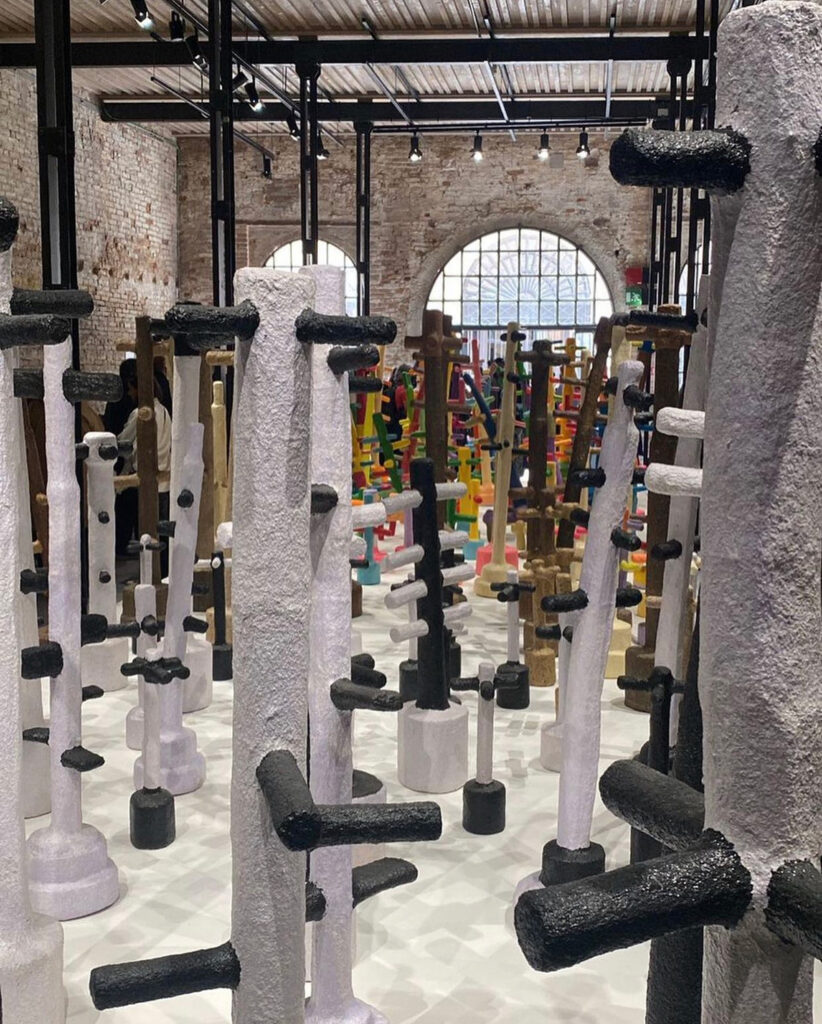
A poet and writer from the 80s generation in UAE, he has published several books about art, poetry, theatre, and novel, including: “In light and shadow, and between them life”, a study on visual arts in the Emirates - Sharjah 2000.


